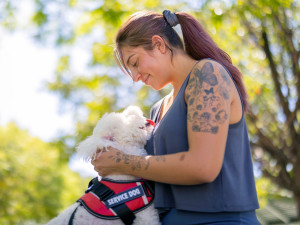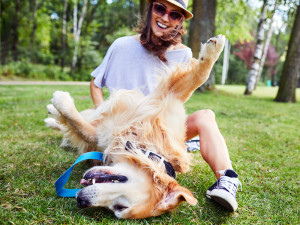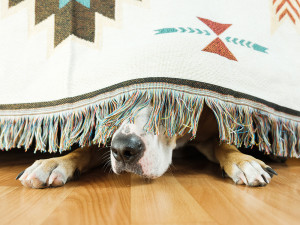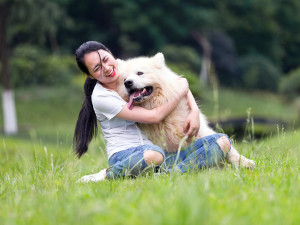What to Do When Your Dog Is Even More Anxious Than You Are
Did you get a dog for emotional support and now they are the one who needs it?
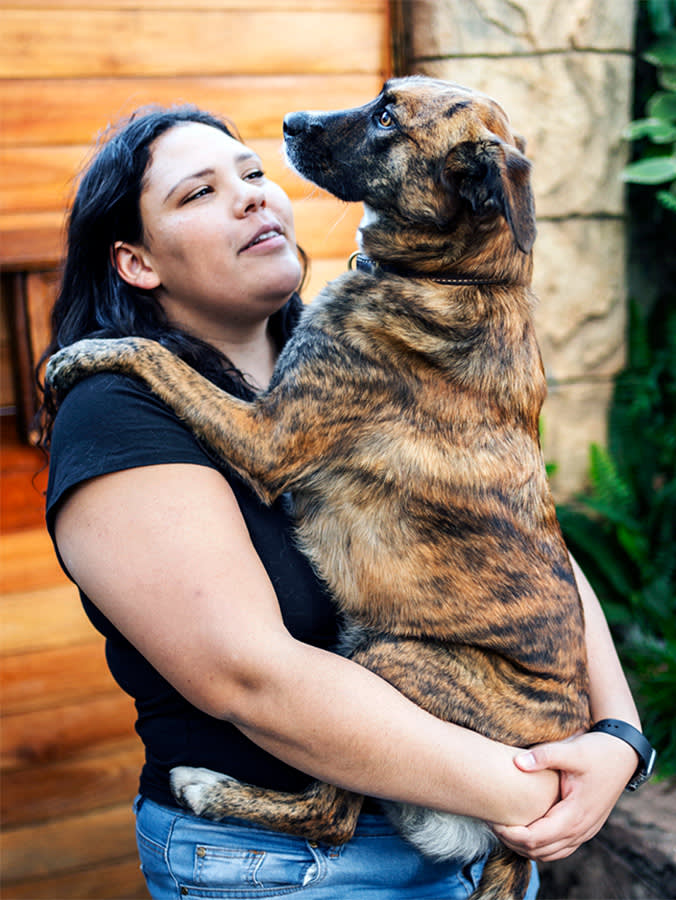
share article
My dog Ava can be a ball of nervous energy. Just like her mother. It’s a real ‘who rescued who’ situation when it comes to soothing our respective anxieties. But, if it’s any consolation to fellow fretters, we are far from alone.
The share of householdsopens in a new tab with pets in the UK jumped from 41 percent in 2020 to 59 percent in 2021, and peaked to an unprecedented high of 62 percent in 2022, likely attributed to more time spent at home during the pandemic – and understandably so. Pets provide companionship, a way to ease stressopens in a new tab, a reason to put on clothes and go outside. Research consistently shows that pets can improve our mental health, and, with a 25 percent global increase in depression and anxietyopens in a new tab during the first year of the pandemic, we’re still reeling from the impact Covid-19 has had on our collective mental health. Of course, as anyone with a dog will tell you, adopting a pet isn’t an emotional cure-all.
Take, for example, all those people on TikTok whose pet’s anxiety is an equal match for their ownopens in a new tab. This can run the gamut from pets experiencing a new-found degree of separation anxietyopens in a new tab as owners return to the office to pets who are on the sameopens in a new tab anti-anxiety medicationopens in a new tab as their owners. I’m convinced Ava has been conducting rigorous studies on how sad her ears must look in order for me to never leave her home alone. The results have been inconclusive as she continues to find even subtler ways to seem sad.
So, what’s a person to do when their emotional support dog needs emotional support of her own?
Is every dog an emotional support dog?
“A Psychiatric Assistance Dog (PAD) is a dog that’s trained to help someone with a long-term mental health diagnosis that severely impacts their day-to-day living,” explains Zoe Norquoy, founder of the Psychiatric Assistance Dogs Foundationopens in a new tab. A PAD differs from other types of assistance dogs in the specific tasks they’re trained to perform (eg, a medical alert dog is trained to alert their handler to a symptom of a medical condition, and a hearing dog will alert their handler to a doorbell or fire alarm). PAD dogs have to go through intense training, so while your current dog could become a certified PAD dog, if they haven’t gone through that level of training, you can still say they’re your ‘emotional support dog’, but only in the same way you might have an emotional support teddy.
What does anxiety look like in dogs?
Dogs can “absolutely” experience anxiety, says Brett Currie, a canine public training and behaviour manager at Wayside Waifs in Kansas City. In addition to more commonly known separation anxiety, dogs can feel anxiousopens in a new tab when they’re afraid, in high-stress situations, and as they age. Unfortunately, we can’t just ask our pets how they’re feeling. (And even if we could, that might still lead to a completely different set of emotional issuesopens in a new tab.)
Dr Parthasarathy says that every dog is different, which means anxiety can look different from pet to pet. Common signs of anxiety to look out for include excessive panting, pacing, tense body posture,and piloerection (hair standing up along your pet’s back or shoulders).
She notes that some signs of anxiety are less obvious, like widened eyes, dilated pupils, and a lowered tail. But, just as it does among people, Dr Parthasarathy says “the specific combination of signs will differ between dogs and may change depending on the situation.”
While other dogs may be more confrontational, Ava is a hider. But she also hides when she pees in the house and finds a dead bug she wants to study (ie, roll in). You know your pet best and, with time and attention, can learn to tell the difference between a nervous wag and an excited one.
What do I do when I can tell my dog is anxious?
We know our dogs don’t live to satisfy our every whim, though sometimes it seems they think we live to serve theirs. (They’re right.) Constant pressure to perform can make anyone anxious, dogs included. Still, it’d be nice if our dogs would, you know, chill out every once in a while.
If you notice your dog seems more anxious than usual, “it's always a good idea to start with a visit to your vet to be sure there's nothing physically wrong that's causing stress or anxiety,” Currie recommends. “As long as their health checks out, it's important to try to identify what is causing their stress and anxiety and give them a break from it.”
Even my attention-seeking Ava needs a break from being pet every once in a while. It’s rare, but it happens. If it’s possible, removing either the source of stress or your pet from the situation is the best first option, both experts say. Unfortunately, this may mean you need to give your pet some space even though your parental instinct makes you want to carry them around in a BabyBjörn.
If it isn’t possible to remove the source of stress (eg, thunderstorms, fireworks, general existential dread), Currie suggests creating a quiet, comfortable space for your dog and providing enrichment toys like frozen Kongs or LickiMats as helpful distractions. Dr Parthasarathy adds that dog parents should also monitor how their dog’s behaviour changes around other people and animals. “The more that people can learn to recognise anxiety, the sooner dogs can get help and often the better the outcomes are for treatment,” she says. For pets that experience anxiety frequently and more severely, Currie says to talk with your vet and a certified trainer about anti-anxiety medications or individualised coping skills for behaviour modification.
OK, but what if my anxiety is exacerbated by my dogs?
Bummer news: Studies suggest that nervous pet owners tend to have nervous pets. Better news: feeling anxious when your dog is experiencing anxiety is totally understandable, says Dr Parthasarathy, adding that “the best thing to do is to try to stay calm”. That is often easier said than done, so Currie suggests finding relaxing activities you and your dog can do together. “Sometimes reading out loud to a pet, going for a walk in a quiet area, or even playing a game of fetch in the yard can help ease your pet’s anxiety, as well as your own.”
Above all, both Currie and Dr Parthasarathy emphasize that it’s OK to ask for help. “It’s always okay to seek professional help if you or your pet are struggling,” Currie says. “There’s no shame in seeking help to make you and your pet more comfortable.”

Mia Mercado
Mia Mercado is a writer whose work has appeared in The New Yorker, New York Times, and The Cut. She’s also the author of two essay collections, She’s Nice Though and Weird But Normal. Mia has a dog named Ava who is an adorable little freak just like her mother.
Related articles
![Dog hiding under the sofa and afraid to go out because he heard fireworks.]() opens in a new tab
opens in a new tabWhy Are Dogs Scared of Fireworks?
How to keep your dog mentally and physically safe this Bonfire Night
![Greyhound dog lying on top of couch looking out of a window]() opens in a new tab
opens in a new tab6 Calming Products That Help My Dog’s Anxiety
Compression vests, interactive toys and pheromone sprays will be game-changers for nervous pups
![Pet parent comforting anxious dog by holding their paw]() opens in a new tab
opens in a new tab8 Tips for Helping an Anxious Dog
Easy ways to calm your pup’s nerves
![woman playing with her dog in the park]() opens in a new tab
opens in a new tabWhy Your Dog Should Be Your Go-To Stress Buster
You need a break sometimes, and your dog is ready (and willing) to take one with you
![Woman and her large white dog sit in grass outside.]() opens in a new tab
opens in a new tabPlaying with Dogs Reduces Stress and Increases Concentration, New Study Finds
Having trouble chilling out or focusing? Maybe it’s time to get a dog
